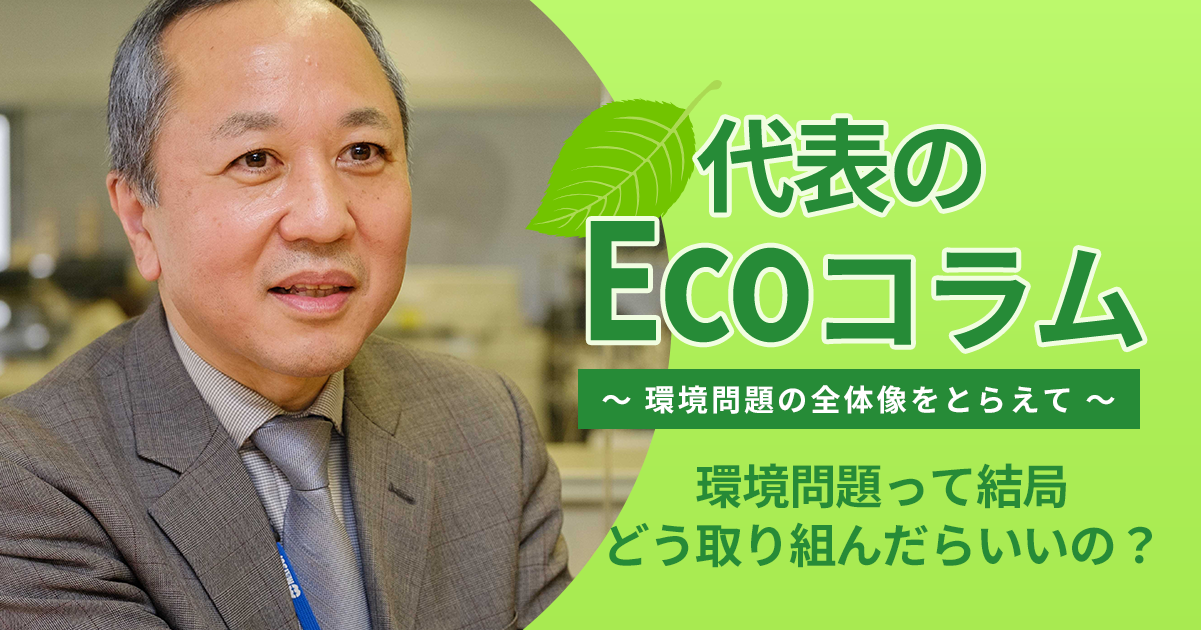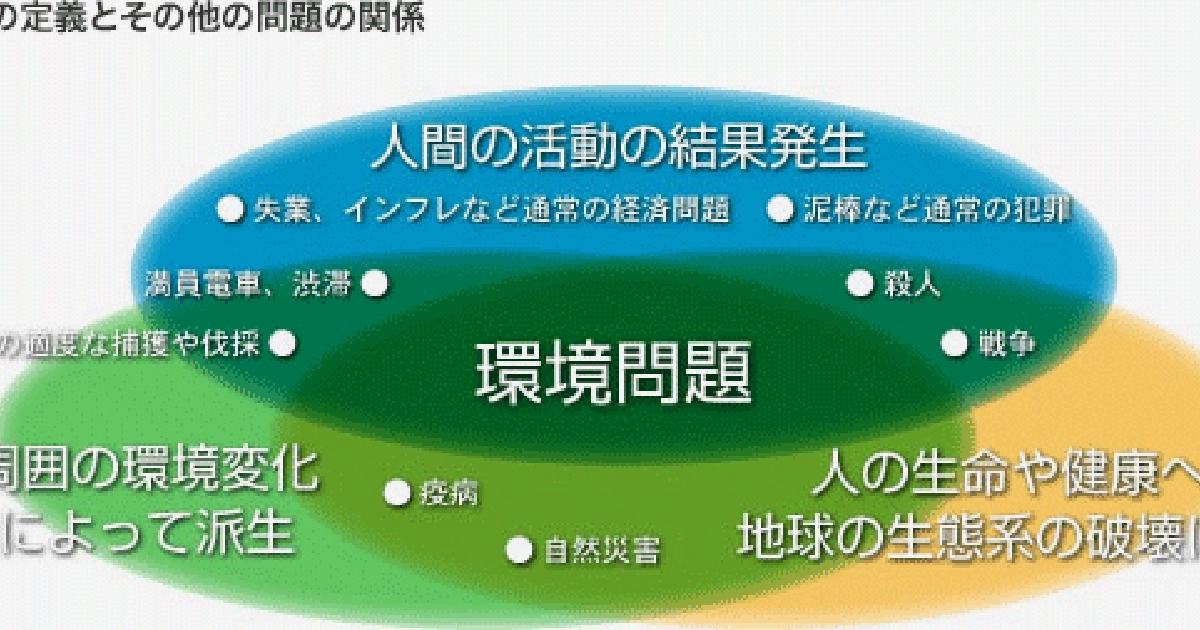代表のEcoコラム
18. 成形工場の factor4 実現への提案例2
2009.11.05
冷却水に関わるムダとトラブルを無くす
前回のコラムでは、『成形工場のfactor 4実現への提案例1』ということで、樹脂乾燥に使われるエネルギーのムダを少なくするための提案を取り上げました。
今回は、成形工場での冷却水に関わるムダとトラブルを少なくする提案を取り上げます。
● 冷却水に関わるムダとトラブル
多くの成形工場では、金型やその他の機器を冷却するために水が用いられます。この冷却水は工場内を循環し、工場内のいろいろな部分から熱を奪います。冷却水が奪った熱は、何らかの形で工場外に放出させてやる必要があります。
循環する冷却水の熱を工場の外に放出するための方法として、次の方法があります。
1.開放式クーリングタワー
最も一般的には、開放式のクーリングタワーが使われています。しかしこの方式では、不純物が外部から入りやすい、水を大量に蒸発させてしまう、さらにそのために循環する冷却水の中に不純物がどんどん濃縮されてしまうなどの問題点があります。水資源をムダに使って、しかもそれが原因で配管内へのスケールの堆積(写真1 )などによるトラブルを引き起こします。
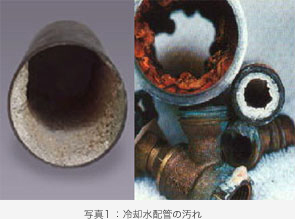
2.密閉式水冷式クーリングタワー
上記の開放式クーリングタワーの問題を避けるために、密閉式水冷式のクーリングタワーがあります。ヨーロッパなどではよく使われているようです。
これは、基本的に循環する冷却水は密閉した配管内を循環するために、不純物がどんどんと濃縮されることはありません。
しかしその代わり、工場外にある熱交換器の外側に直接水をかけて、その水を蒸発させることにより、熱交換器の内部を流れる循環水から熱を奪います。このためやはり水は大量に消費され、しかも熱交換器に不純物が濃縮して堆積しやすく、定期的に洗浄や交換が必要になります。
3.集中式空冷式チラー
水を蒸発させないで循環水を冷やすために、工場全体の水の冷却に集中式の空冷式チラーを使う場合もあります。
この方式では、循環する冷却水は密閉した配管内を循環するために、不純物がどんどんと濃縮されることはありませんし、その水を冷やすために空冷式の冷凍機を用い、水を一切使わないので、メインテナンスの必要もあまりなくなります。
しかし、初期費用は上記のものよりかなり高くなります。さらに冷凍機を用いることで多量の電気エネルギーを消費します。
せっかく多量の電気エネルギーを使って冷やした水を、金型の冷却時には再度ヒーターで加熱して使用するというムダが起こっていることが非常にたくさん見受けられます。
● 水のムダとトラブルを無くす「ecobrid」
我々は、上記のような問題点を解決するために、「ecobrid」(写真2 )という密閉式で空冷式のクーリングタワーを提案しています。
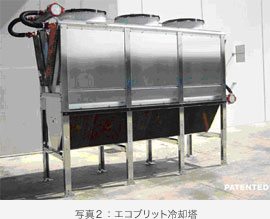
ecobridは、循環水の蒸発がなく、従って不純物が濃縮されることによるトラブルはありません。さらに工場外にある熱交換器の外側にも、水を直接かけることはせず、ファンによる空気の流れによって熱交換器を冷やし、それによって内部の循環水を冷却します。そのために熱交換器にスケールなどの不純物の堆積もなく、熱交換器自体の洗浄や交換などは不要です。
しかし、これだけでは、夏場などの暑い時は、単なる空冷だけでは十分に冷却できない場合があります。そのような場合には、ecobridでは、外気温が30℃を超える場合、ファンにより流れる空気中に水を霧状に噴霧し空気中に気化させます。それにより空気の温度は、その気化熱の分だけ低下します。例えば、湿度40%で42℃の外気は、水の噴霧によって、湿度70%で30℃の空気にすることができます。このように温度を低くした空気によって熱交換器を冷やすことを行い、夏場の暑い時でも、常時25℃~35℃以下の水を得ることが可能になります(図1 )。
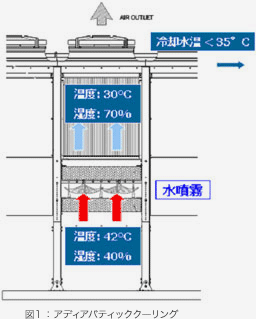
図2 に通常の開放式クーリングタワーとecobridの水および電力の消費量を当社のフィールドテストで比較した結果を示します。水の消費量は1/200程度、電力の消費量は、1/2程度となっています。しかも2年を経過しても、水質の悪化や水質によるトラブル、熱交換器への不純物の堆積などは見受けられていません。
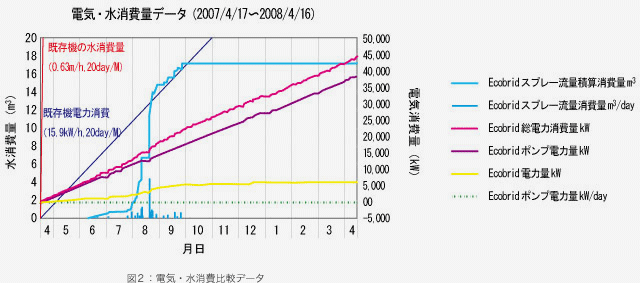
● 水の冷却に関わるエネルギーのムダ
ecobridでは、常時35℃以下の水を得ることが可能と書きましたが、実際の成形工場では、35℃以下の冷却水が必要なことももちろんあります。そのような場合どのように対応する方法があるでしょうか?
例えば、常時25℃の冷却水が必要なラインが一部あるとする場合。
1.クーリングタワーを使わず、工場全体の循環水を集中式の空冷式チラーで冷却する。
この場合、25℃までの低温の水が必要ないところに対しても、わざわざ必要以上の低温の水を供給することになり、場合によっては再度ヒーターで水を温めることになってしまい、エネルギー的に膨大なムダが発生します。
2.工場全体の循環水は、クーリングタワー(ecobrid含む)で冷却するが、25℃の水が必要なラインにのみ個別に小型チラーで冷却する。
この場合は、必要な箇所のみに小型のチラーが設置されるので、上記の場合よりもエネルギーのムダは少なくなります。しかしこの場合、通常の小型チラー導入したラインでは、夏はもちろんですが、冬の寒いときでもわざわざチラーを動作させることになります。冬などの寒いときは、工場外のクーリングタワーを通った水は、わざわざチラーを使わなくても25℃以下に冷却されています。ここでも大きなエネルギーのムダが発生します。
● 水の冷却に関わるエネルギーのムダを無くす「フリークーリング」
我々は、上記のようなムダを無くすために、「ecobrid」+「個別小型チラー」+「フリークーリング」 を組み合わせることを提案しています。
フリークーリングとは、冬などの寒い時期には、チラーを運転せず、ecobridやクーリングタワーなどの冷却塔のみで水を冷却するシステムです。
つまり、ecobridで冷却した水が25℃以上になってしまうときだけ、チラーを運転し、それ以外の時は、ecobridのみで25℃に冷却水をそのまま利用するわけです。通常のクーリングタワーの水では水質の問題でこのように、外部クーリングタワーの水が十分に冷たくても、例えば金型冷却にそのまま用いることは出来ない場合が多いですが、ecobridであれば、水質の問題はなく、このように直接金型の冷却水としても利用することができます。
このことにより、例えば、(図3 )のように年間でチラーで消費する電力を50%以上低減 することが可能になります。
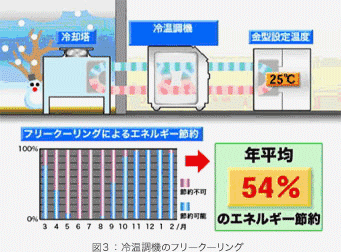
弊社では、このフリークーリングの機能が内蔵した小型の冷温調機として既に「Microgel」を提供しています。さらに既存のチラーや冷温調機に対しても、後付でフリークーリングの機能をつけるためのオプション も近日中に提供できるようにするよう進めています。
我々の目指す「factor 4」は、単に資源のムダを無くすだけのことではありません。消費資源を半分にしながらも、生産量を2倍にすることを目指しています。
次回のコラムでは、「生産量2倍」ということに対して、時間当たりの生産量を増やすための金型にまで踏み込んだ提案例を取り上げます。
2009年11月05日 松井 宏信

